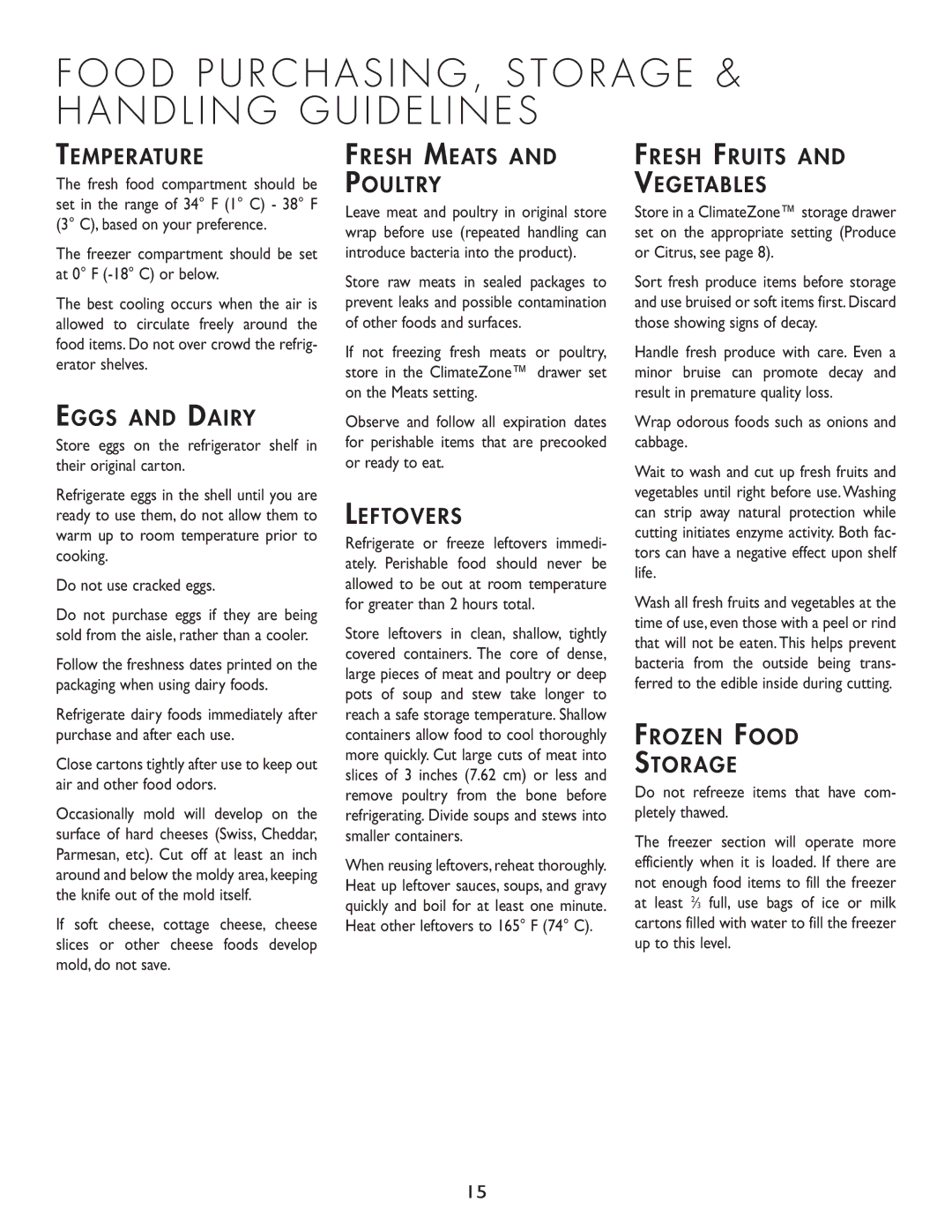F O O D P U R C H A S I N G , S T O R A G E & H A N D L I N G G U I D E L I N E S
TEMPERATURE
The fresh food compartment should be set in the range of 34° F (1° C) - 38° F (3° C), based on your preference.
The freezer compartment should be set at 0° F
The best cooling occurs when the air is allowed to circulate freely around the food items. Do not over crowd the refrig- erator shelves.
EGGS AND DAIRY
Store eggs on the refrigerator shelf in their original carton.
Refrigerate eggs in the shell until you are ready to use them, do not allow them to warm up to room temperature prior to cooking.
Do not use cracked eggs.
Do not purchase eggs if they are being sold from the aisle, rather than a cooler.
Follow the freshness dates printed on the packaging when using dairy foods.
Refrigerate dairy foods immediately after purchase and after each use.
Close cartons tightly after use to keep out air and other food odors.
Occasionally mold will develop on the surface of hard cheeses (Swiss, Cheddar, Parmesan, etc). Cut off at least an inch around and below the moldy area, keeping the knife out of the mold itself.
If soft cheese, cottage cheese, cheese slices or other cheese foods develop mold, do not save.
FRESH MEATS AND POULTRY
Leave meat and poultry in original store wrap before use (repeated handling can introduce bacteria into the product).
Store raw meats in sealed packages to prevent leaks and possible contamination of other foods and surfaces.
If not freezing fresh meats or poultry, store in the ClimateZone™ drawer set on the Meats setting.
Observe and follow all expiration dates for perishable items that are precooked or ready to eat.
LEFTOVERS
Refrigerate or freeze leftovers immedi- ately. Perishable food should never be allowed to be out at room temperature for greater than 2 hours total.
Store leftovers in clean, shallow, tightly covered containers. The core of dense, large pieces of meat and poultry or deep pots of soup and stew take longer to reach a safe storage temperature. Shallow containers allow food to cool thoroughly more quickly. Cut large cuts of meat into slices of 3 inches (7.62 cm) or less and remove poultry from the bone before refrigerating. Divide soups and stews into smaller containers.
When reusing leftovers, reheat thoroughly. Heat up leftover sauces, soups, and gravy quickly and boil for at least one minute. Heat other leftovers to 165° F (74° C).
FRESH FRUITS AND VEGETABLES
Store in a ClimateZone™ storage drawer set on the appropriate setting (Produce or Citrus, see page 8).
Sort fresh produce items before storage and use bruised or soft items first. Discard those showing signs of decay.
Handle fresh produce with care. Even a minor bruise can promote decay and result in premature quality loss.
Wrap odorous foods such as onions and cabbage.
Wait to wash and cut up fresh fruits and vegetables until right before use. Washing can strip away natural protection while cutting initiates enzyme activity. Both fac- tors can have a negative effect upon shelf life.
Wash all fresh fruits and vegetables at the time of use, even those with a peel or rind that will not be eaten. This helps prevent bacteria from the outside being trans- ferred to the edible inside during cutting.
FROZEN FOOD
STORAGE
Do not refreeze items that have com- pletely thawed.
The freezer section will operate more efficiently when it is loaded. If there are not enough food items to fill the freezer at least 2⁄3 full, use bags of ice or milk cartons filled with water to fill the freezer up to this level.
15
